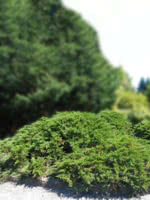Mon-Fri 9am - 5pm Mountain time
Western Snowberry vs Tamarix Juniper
Symphoricarpos occidentalis
Juniperus sabina Tamariscifolia
NOT AVAILABLE THIS SEASON - MIGHT RETURN
CUSTOM GROW
Like the Common Snowberry, the Western Snowberry is a small shrub with pink flowers useful for feeding livestock and preventing erosion. Unlike the common species, however, the Western Snowberry is much more suited to wet conditions, capable of persevering through poor soil drainage and occasional flooding.
After the Snowberry's flowers have bloomed, it produces berries which often last on the plant through winter. These berries are toxic to humans, but livestock and local wildlife love them! Those hoping to attract wildlife to their property can plant Snowberry and expect to see animals foraging on it much later in the year than other plants.
Tamarix Juniper has attractive, year round, blue-green foliage that will pop on a winter landscape. Not only does it provide winter interest, Tamarix Juniper is unique in that it does not “hug” the ground as one would expect. If you're looking for a shrub that is low maintenance, rabbit resistant, and tolerant of a variety of conditions, try Tamarix Juniper.
Western Snowberry Quick Facts
Tamarix Juniper Quick Facts
Toxicity: berries are toxic to humans

